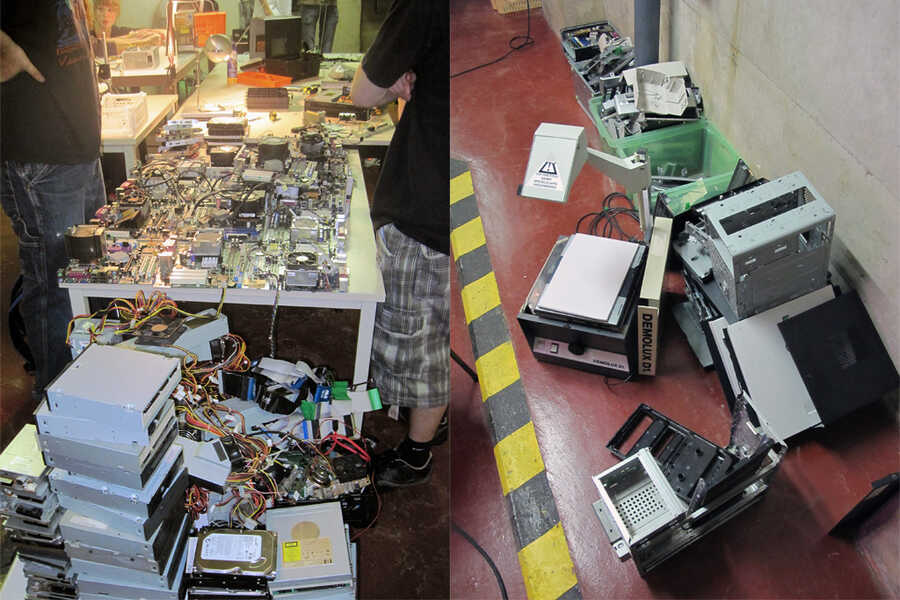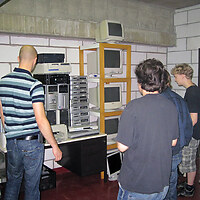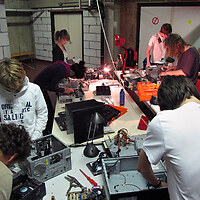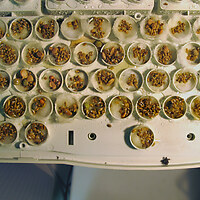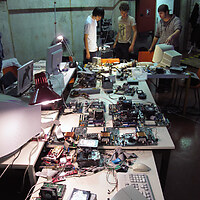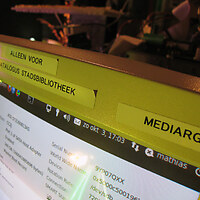It’s the interchangeability of PC computer components that allows for this. Parts of computers from different brands (and different ages) can be easily connected and recombined into functional workstations. Moreover, the ubiquitous rectangular computer case is not strictly needed to build a computer. Parts can be assembled onto whatever structure available – allowing for a wide range of creative structures. Essentially, these ideas come from both the case modding and hacking scene. In case modding, computer cases are transformed into elaborately decorated pieces. It is a dynamic subculture with active Internet forums, international contests, and specialized hardware such as intricate heat sinks and colourful cold cathode lighting. The hacking scene has traditionally been interested both in software and hardware hacking. Most new digital consumer goods get hacked in a matter of days after their release, after which instructions are posted online. Famous examples are the 'jailbreaking' of the iPhone, and hacking of the Kinect motion sensor. Apart from technically taking apart computers, Biomodd participants are explicitly invited to explore the 'sculptural' potential of electronics, and to find original ways to build computers. This includes the incorporation of living organisms in systems in which electronics and biology co-exist, another core concept of Biomodd.
Before the start of the Biomodd Workshop in Sint-Niklaas, a good amount of used equipment was collected: about 20 computers, 10 monitors, and different peripherals such as network switches and printers. The materials were donated by local schools and computer shops in Sint-Niklaas, a computer refurbishing company in Antwerp (PUC), and the municipal library where the workshop was held. The participants took apart all computers in one single morning session during the first workshop day. I had expected this to take at least one full day, but people were extremely motivated to put their hands on the computers. They eagerly opened up case after case to carefully unscrew and remove all individual components. Whenever somebody got stuck, one of the other participants would spontaneously come over and help out. Theo, a computer refurbishing professional even admitted that he learned about taking apart HP computers. He had been struggling in his company before with opening up a specific type of HP computer case. During the workshop he noticed that one of the teenage participants explored the case for about 15 minutes and then simply figured it out. Theo went over and got a detailed explanation on how to do it.
At the end of this session, everything was sorted: motherboards, hard drives, optical drives, memory modules, power supply units, etc. The fact that all components were pooled together in one central supply gave the group a sense of shared purpose. After some time, it simply became impossible to tell which individual component had been taken out by who. All waste was sorted separately: metal scrap, plastic parts, and dysfunctional electronics. Some of the metal and plastic was used afterwards as construction material. All of recovered components and waste became an integral part of the Biomodd installation during the Coup de Ville arts festival. At the end of the exhibition, materials were adopted by participants or transferred to a local recycling centre.

